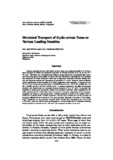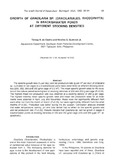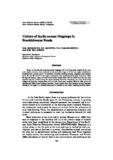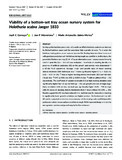Simulated transport of Scylla serrata zoeae at various loading densities
Share
Abstract
Percent mortality of mud crab Scylla serrata zoeae was determined after 6 h of simulated transport at mobile and stationary conditions at loading densities of 10, 20, 30 and 40 x 103 ind-l-1. Mortality was not significantly different among treatments immediately after transport. Surviving zoeae were stocked in basins, fed with Brachionus rotundiformis and mortality was compared 15 h after transport. There was no significant interaction between loading density and condition (mobile and stationary) of transport (P > 0.05). However, larval mortality varied significantly among densities (P < 0.001) regardless of the condition. A density of 10 x 103 ind-l-1 had the lowest mortality (0.56 ± 0.76%) followed by 20 x 103 (1.28 ± 0.39%), 30 x 103 (4.3 ± 0.25%), and 40 x 103 (4.3 ± 0.31%) ind-l-1. In another experiment, the effect of transport duration was determined at a constant loading density of 10 x 103 ind-l-1 in control (not subjected to packing and transport), shaken and unshaken conditions. Zoea mortality did not differ significantly (P > 0.05) after the 6, 9, and 12 h transport. Regardless of the duration, mortality was lowest in the control (0.41 ± 0.05%) compared to those in the shaken (0.99 ± 0.13%) and unshaken (0.79 ± 0.12%) conditions. Likewise, the condition but not the duration of transport affected larval survival at 15 h post-transport. Mortality was lower in the shaken (1.92 ± 0.22%) than in the unshaken condition (2.46 ± 0.17%). Since mortality is low even at 20 x 103 ind-l-1, this can still be used to transport S. serrata zoeae for 6 h. However, loading density should be reduced to 10 x 103 ind-l-1 for transport duration up to 12 h.
Suggested Citation
Quinitio, E. T., & Parado-Estepa, F. D. (2001). Simulated transport of Scylla serrata zoeae at various loading densities. Asian Fisheries Science , 14(2), 225-230. http://hdl.handle.net/10862/1909
Subject
Collections
- AQD Journal Articles [1215]
Related items
Showing items related by title, author, creator and subject.
-
Growth of Gracilaria sp. (Gracilariales, Rhodophyta) in brackishwater ponds at different stocking densities.
de Castro, Teresa R.; Guanzon, Nicolas G., Jr. (Society of Israeli Aquaculture and Marine Biotechnology, 1993)The specific growth rate (% per day) and net production rate (g per m2 per day) of Gracilaria sp. cultivated in net cages in a brackishwater pond were determined at different stocking densities (200, 250, 300 ... -
Culture of Scylla serrata megalops in brackishwater ponds
Rodriguez, E. M.; Quinitio, E. T.; Parado-Estepa, F. D.; Millamena, O. M. (Asian Fisheries Society, 2001)Three- to five-day old hatchery-reared megalops (4.0 to 6.4 mg body weight) of the mud crab, Scylla serrata, were cultured to the juvenile stage in 20 m2 net cages installed in brackishwater nursery ponds. To ... -
Viability of a bottom-set tray ocean nursery system for Holothuria scabra Jaeger 1833
Gorospe, Jay R. C.; Altamirano, Jon; Juinio-Meñez, Marie Antonette (Wiley, 2017)Scaling up the hatchery production of juvenile sandfish Holothuria scabra is constrained by limited hatchery space and the associated high operational costs. To shorten the hatchery rearing phase, ocean nursery systems ...





